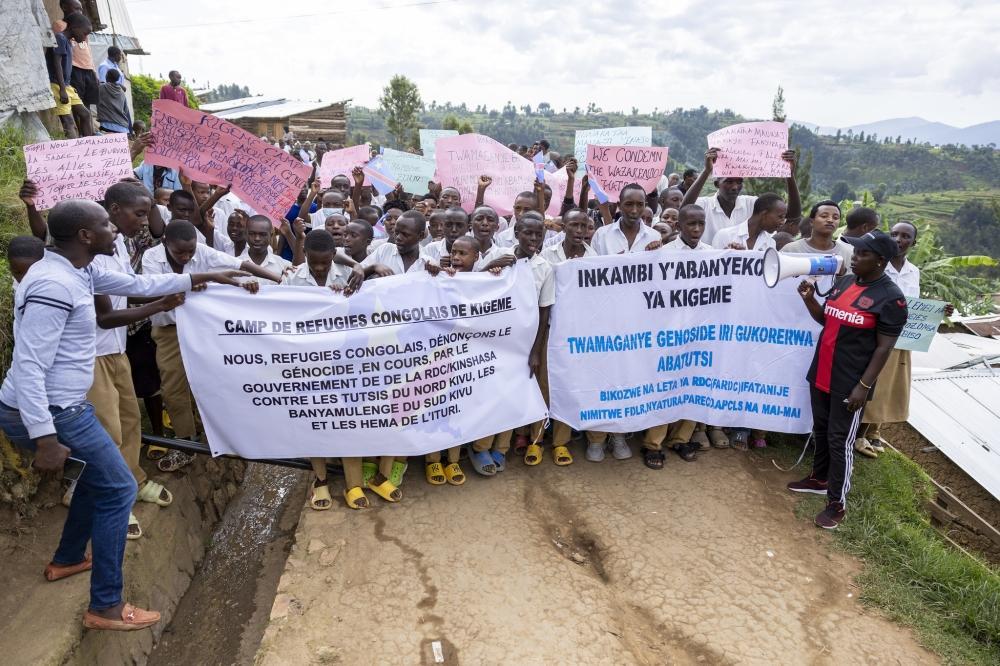Amani Athar
Africa-Press – Rwanda. Today marks 28 years since the FDLR, then known as ALIR, launched its abhorrent attacks that targeted the Congolese Tutsi Refugee Camp in Mudende, in northwestern Rwanda.
It was on August 22, 1997, that this group, blacklisted as a terrorist group because of the horrendous crimes it committed on Congolese territory, crossed into Rwanda and attacked the Mudende camp, which hosted about 8,000 refugees, and killed more than 1,000 of them. Until today, the survivors, who relocated to other refugee camps in Rwanda, and some in Uganda, have yet to return to the land of their ancestors.
Their hope was bolstered by the recent agreement signed between the government of Rwanda and DR Congo in Washington, aiming at ending decades of conflict in the Great Lakes region. The agreement offers a chance for the refugees to return home if the FDLR is neutralised and the cycle of Tutsi killings in DR Congo brought to an end.
It is not a secret to anyone that their safe return is highly contingent on the FDLR ceasing their armed activities and dismantlement, without which the instability and violence they perpetrate in eastern DR Congo will continue to prevent refugees from returning home and will hinder the establishment of lasting peace.
Anyone can pretend to ignore the FDLR atrocities, or can say that they have been significantly weakened and should not be a threat. But not Congolese Tutsi refugees, victims of their crimes. There is a proverb in Kinyarwanda that says ‘nta we utinya ijoro, atinya icyo bahuriye mo.’ Meaning ‘no one fears the night, but rather what one had encountered within it’.
The Congolese Tutsi refugees encountered the FDLR atrocities in the eastern DR Congo in 1996. Some of them still remember how they survived the killing on the night of 22 August, 1997 in Mudende. They have been following what the notorious FDLR and their allies, the Mai Mai and Wazalendo, have been doing against their brothers and sisters who stayed home.
Over the last 30 years, they have been following acts of lynching and cannibalism against Congolese Tutsi, hundreds, if not thousands, of women raped, herdsmen killed and thousands or millions of cows raided. In addition, thousands of Tutsi have fled their villages in Masisi, Kalehe, Nyirangongo, and Rutshuru, to join them in Uganda and Rwanda because of ethnic persecution by the FDLR and their allies, with the support of the Congolese armed forces.
They remember their 166 colleagues who were brutally killed in Gatumba, western Burundi, by the FDLR, which acted with FNL-Palipehutu, another extremist Burundian group that was at the time based in DR Congo.
It should be noted that a forgotten group of more than 1,500 displaced Congolese Tutsis who have been in the ACOGENOKI site in Keshero since 2022 have been deprived of humanitarian assistance. In a report dated April 18, 2024, from the provincial governorate of North Kivu on the humanitarian situation, all the sites of displaced persons in North Kivu were mapped, except for the Keshero one, containing “displaced Congolese Tutsi.” We hope that the AFC/M23 remembered them.
It should also be remembered that the U.S. Department of State, in December 2001 added FDLR, then known as “ALIR” to the terrorist list under the provisions of the Patriot Act, after the group murdered eight Western tourists in Bwindi, including two Americans.
This group, also in February 2021 killed the Italian Ambassador to DR Congo, Luca Attanasio. Then-Governor of North Kivu Province, Carly Nzanzu, said that the attack was carried out by the FDLR.
Today, Rwanda hosts close to 100,000 Congolese Tutsi refugees. Many of them have been in Rwanda since 1996, and recent violence in eastern DR Congo has led to a daily influx of asylum seekers.
In Uganda, the exact number of Congolese Tutsi refugees is not known, but the country hosts nearly 600,000 Congolese refugees in total. While the right figures for Congolese Tutsi refugees in Kenya and Burundi are not known, both countries do host them.
The whole world knows that hundreds of thousands, if not millions, of Congolese Tutsi have lived as refugees not only in East Africa, but across many countries around the world, many of them in the Tanzania, South Africa, U.S., Canada, Australia, France and Belgium for decades, and the world seems to forget that they all have a dream to return to their homeland and cease to be called stateless.
The Rwanda-DR Congo peace agreement specifically addresses the FDLR, and calls for the implementation of a previously agreed-upon plan for neutralizing the militia.
It is by neutralizing this notorious and terrorist group that the Congolese Tutsi refugees can feel safe to return home. Needless to say, their ordeals intensified following the Genocide against the Tutsi of Rwanda in 1994.
It will not be easy to dismantle the FDLR, which is integrated in the DR Congo armed forces. But for peace to reign, not only for the Congolese Tutsi refugees, but also the entire Great Lakes Region, the FDLR must be dismantled, either voluntarily or by force. Only then can the region finally breathe peace.
Source: The New Times
For More News And Analysis About Rwanda Follow Africa-Press






